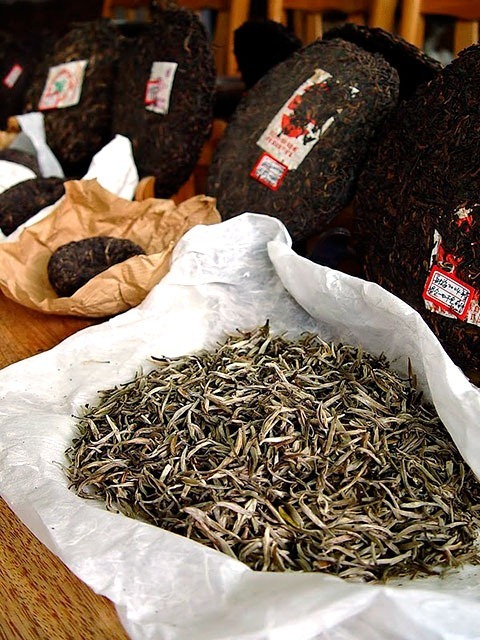
Over time, raw pu-erh acquires an earthy flavor due to slow oxidation and other, possibly microbial processes. However, this oxidation is not analogous to the oxidation that results in green, oolong, or black tea, because the process is not catalyzed by the plant's own enzymes but rather by fungal, bacterial, or autooxidation influences. Pu-erh flavors can change dramatically over the course of the aging process, resulting in a brew tasting strongly earthy but clean and smooth, reminiscent of the smell of rich garden soil or an autumn leaf pile, sometimes with roasted or sweet undertones. Because of its ability to age without losing "quality", well aged good pu-erh gains value over time in the same way that aged roasted oolong does.
Raw pu-erh can undergo "wet storage" (shīcāng, 湿仓) and "dry storage" (gāncāng 干仓), with teas that have undergone the latter ageing more slowly, but thought to show more complexity. Dry storage involves keeping the tea in "comfortable" temperature and humidity, thus allowing the aging process to occur slowly. Wet Storage or "humid storage" refers to the storage of pu-erh tea in humid environments, such as those found naturally in Hong Kong, Guangzhou and, to a lesser extent, Taiwan.
The practice of "Pen Shui" 喷水 involves spraying the tea with water and allowing it dry off in a humid environment. This process speeds up oxidation and microbial conversion, which only loosely mimics the quality of natural dry storage aged pu-erh. "Pen Shui" 喷水 pu-erh not only does not acquire the nuances of slow aging, it can also be hazardous to drink because of mold, yeast, and bacteria cultures.
Pu-erh properly stored in different environments can develop different tastes at different rates due to environmental differences in ambient humidity, temperature, and odours. For instance, similar batches of pu-erh stored in the different environments of Taiwan and Hong Kong are known to age very differently. Because the process of aging pu-erh is a lengthy one and teas may change owners several times, a batch of pu-erh may undergo different aging conditions, even swapping wet and dry storage conditions, which can drastically alter the flavor of that tea. Raw pu-erh should not be stored at very high temperatures, or be exposed to direct contact with sunlight, heavy air flow, liquid water, or unpleasant smells, since such poor storage conditions can ruin even the best quality pu-erh.
Although low to moderate air flow is important for producing a good quality aged raw pu-erh, it is generally agreed by most collectors and connoisseurs that raw pu-erh tea cakes older than 30 years old should not be further exposed to "open" air since it would result in the loss of flavours or degradation in mouthfeel. The tea should instead be preserved by wrapping or hermetically sealing it in plastic wrapping or ideally glass.


Wow, fantastic blog layout! How long have you been blogging for?
you make running a blog look easy. The entire glance of your site
is wonderful, as neatly as the content material! You can see similar here sklep
Hey very nice site!! Man .. Excellent .. Amazing .. I will bookmark your blog and take the feeds also…I'm happy to find a lot of useful information here in the post, we need work out more strategies in this regard, thanks for sharing. . . . . .
Very well written post. It will be helpful to everyone who employess it, including myself. Keep doing what you are doing - for sure i will check out more posts.
Hey there, You have done an incredible job. I will certainly digg it and for my part recommend to my friends. I'm confident they'll be benefited from this site.
дизайн человека расчет
хьюман дизайн бесплатно
Hey there! Would you mind if I share your blog with my twitter group? There's a lot of folks that I think would really appreciate your content. Please let me know. Thank you
Valuable info. Lucky me I found your website by accident, and I'm shocked why this accident didn't happened earlier! I bookmarked it.
I am continually searching online for tips that can assist me. Thank you!
We're a group of volunteers and starting a new scheme in our community. Your site provided us with valuable information to work on. You have done an impressive job and our whole community will be thankful to you.